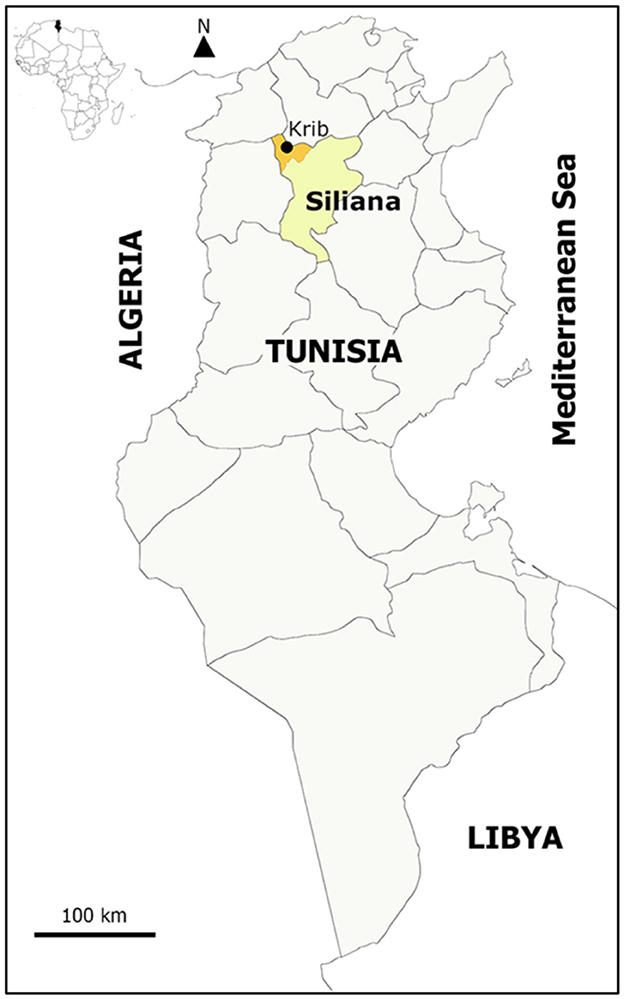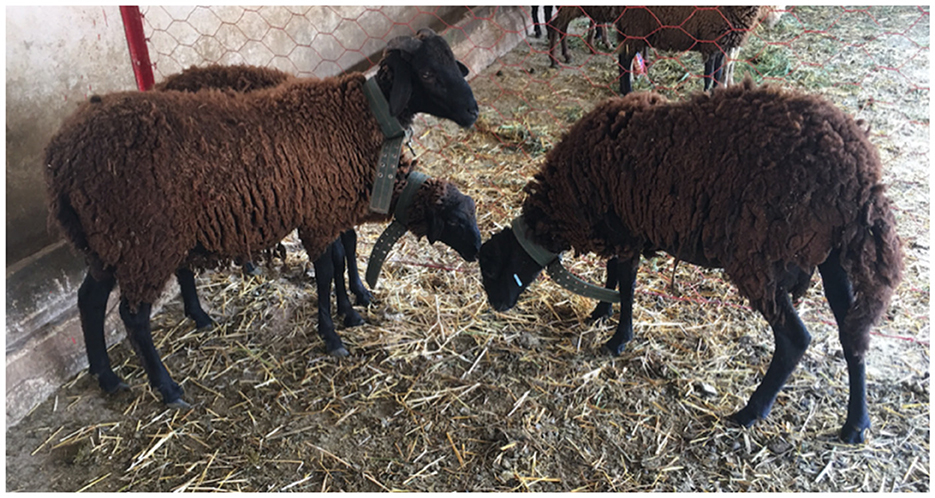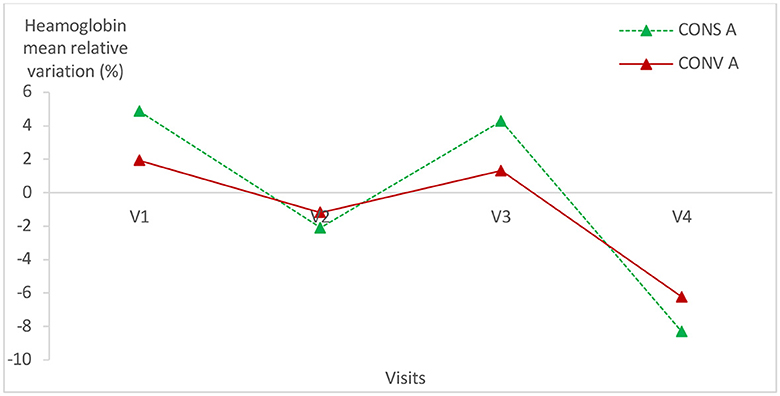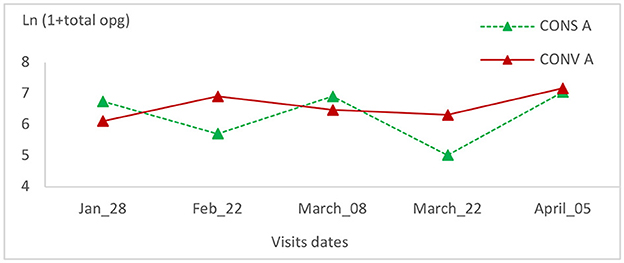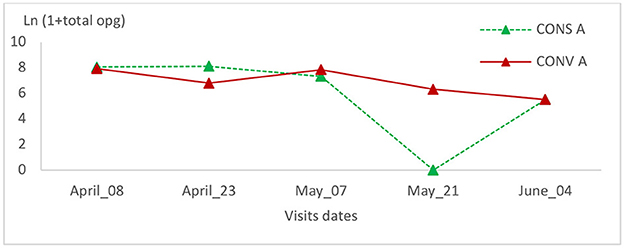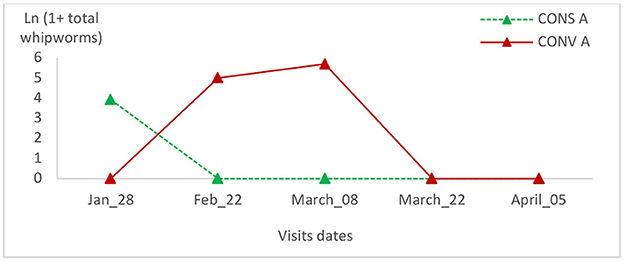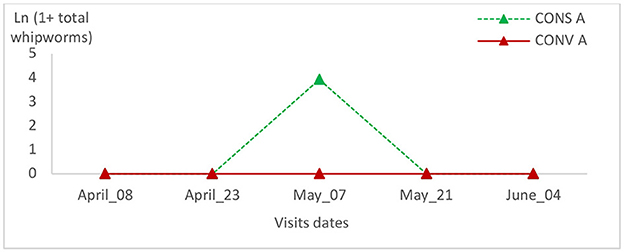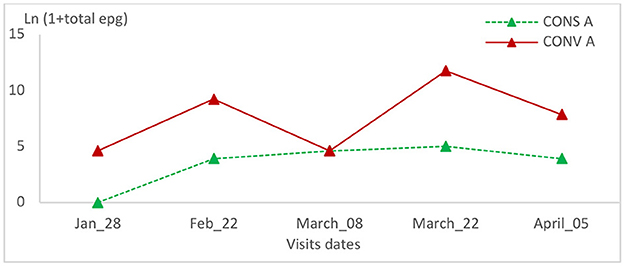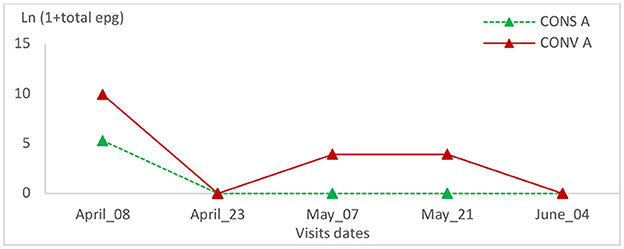- 1Ruminant Internal Medicine Service, Institution de la Recherche et de l'Enseignement Supérieur Agricoles, École Nationale de Médecine Vétérinaire de Sidi Thabet, Université de la Manouba, Sidi Thabet, Tunisia
- 2Laboratoire de Parasitologie, Institution de la Recherche et de l'Enseignement Supérieur Agricoles, École Nationale de Médecine Vétérinaire de Sidi Thabet, Université de la Manouba, Sidi Thabet, Tunisia
- 3International Center for Agricultural Research in the Dry Areas (ICARDA), Amman, Jordan
- 4Institut National des Recherches Agronomiques de Tunis (INRAT), Tunis, Tunisia
Conservation agriculture (CONS A) is a sustainable agriculture system based on crop rotation with no tillage. It has various environmental advantages compared to conventional agriculture (CONV A): decreased water evaporation, erosion, and CO2 emissions. In this first study of its kind, we aim to evaluate the impact of this type of agriculture on sheep gastrointestinal parasites. Two lamb groups aged between 5 and 10 months were randomly included to graze separately on CONS A and CONV A pastures. Each group was composed of two batches of three lambs, and these were followed up for two rearing months. Liveweight, hematological parameter variation, and digestive parasites were studied. At the end of the study period, lambs were slaughtered the carcass yield was determined, and a helminthological autopsy was performed on the digestive tracts of the animals to estimate different parasitological indicators. There was no difference between lambs reared on CONS A and those reared on CONV A for all parasite indicators (infestation intensity, abundance, and prevalence). The same trend was also obtained for hematological parameters, liveweight evolution, and carcass yield. These results prove that there is no impact of CONS A on the sheep's digestive parasitism. Further studies are needed to support these findings on larger animal samples and to investigate the impact of conservation agriculture on other parasite species. Similar studies could also be conducted on ruminant species.
1. Introduction
Conservation agriculture (CONS A) or regenerative agriculture is a sustainable model that does not disturb the ecosystem and preserves natural resources (1). It contributes to the preservation of the physico-biological properties of the soil and its mesofauna and microfauna, which has a positive impact on soil fertility and productivity.
Owing to the presence of a permanent vegetative cover, CONS A protects the soil from erosion and reduces the evaporation of water. However, it decreases the release of CO2 gases from the ground (2), reducing climate warming (3–7).
The livestock-crop association leads to several ecological benefits. It replaces chemical fertilizers with organic fertilizer made from livestock droppings that are naturally rich in minerals (phosphorus and nitrogen). This generates a balance or a mutual profile between crops and livestock populations (8). Besides, it was proven that there is an efficiency of crop-livestock production systems under CONS A with the guarantee of sustainable food security in Tunisian dry areas (9, 10).
Numerous studies have proven that parasitic diseases are widespread throughout the world. They cause high financial losses that were estimated at ~1.8 billion euros in 18 countries of the European Union (11). In Tunisia, parasites represent an important health problem in sheep since the parasitic fauna is very diversified, with a high infestation/infection prevalence (a large proportion of animals have parasites) and intensity (high parasitic burdens in the majority of animals).
Moreover, sheep digestive parasitism in CONV A has a high impact due to the high infestation prevalence (a high proportion of animals are infected by these parasites), the high intensity (infected animals have high parasitic burdens), and the parasite diversity (a very large fauna of parasites are infecting animals). For example, Tariq et al. (12) mentioned that more than 67% of sheep were infected by gastrointestinal nematodes (GIN) in CONV A of the Kashmir Valley, India, and Krishnamoorthy et al. (13) reported an overall prevalence of 65% in CONV A grazing sheep in semiarid areas of India between 1998 and 2021. Waruru et al. (14) reported a high prevalence of GIN (51.6%), Eimeria spp. (31.5%), and tapeworms (28%) in Machakos District, Kenya.
Indeed, a very high infection prevalence by gastrointestinal nematodes was reported in Tunisia. They affect between 70 and 100% of tested animals (15, 16). Animals infected by gastrointestinal nematodes shed a very high number of eggs that hatch and give three successive larval instars daily in their feces. The probability that these four stages survive in the environment closely depends on three abiotic factors (temperature, hygrometry, and oxygenation). For this reason, soil management dramatically influences the epidemiological pattern of digestive gastrointestinal parasites, including protozoa (mainly Eimeria spp.), intestinal imaginal cestodes (adult tapeworms), and gastrointestinal nematodes.
The aim of the present comparative preliminary study was to investigate the impact of CONS A on these three groups of sheep digestive parasites, the hematological indicators of anemia, and weight indicators (liveweight and yield carcass). These outputs will provide animal decision-makers with a very important dataset about the potential parasitic management that could be recommended when sheep graze on CONS A.
2. Materials and methods
2.1. Study farm
The present study was conducted on a private farm in the Krib locality, Siliana district, Northwest Tunisia (Latitude: 36.374471 E; Longitude: 9.175250 N) (Figure 1).
The Krib locality has a Köppen BSk climate type with an average annual rainfall between 250 and 600 mm and mean winter and summer temperatures of 17.8 and 35°C, respectively (17). The study land consists of two contiguous plots, one used for conservation agriculture (CONS A) and the other for conventional agriculture (CONV A) (Figure 2). Agricultural activities were similar and performed at the same time in both plots. Both of them were planted with oats (Avena sativa), vetch (Vicia sativa), sulla (Hedysarum coronarium), and alfalfa (Medicago sativa).
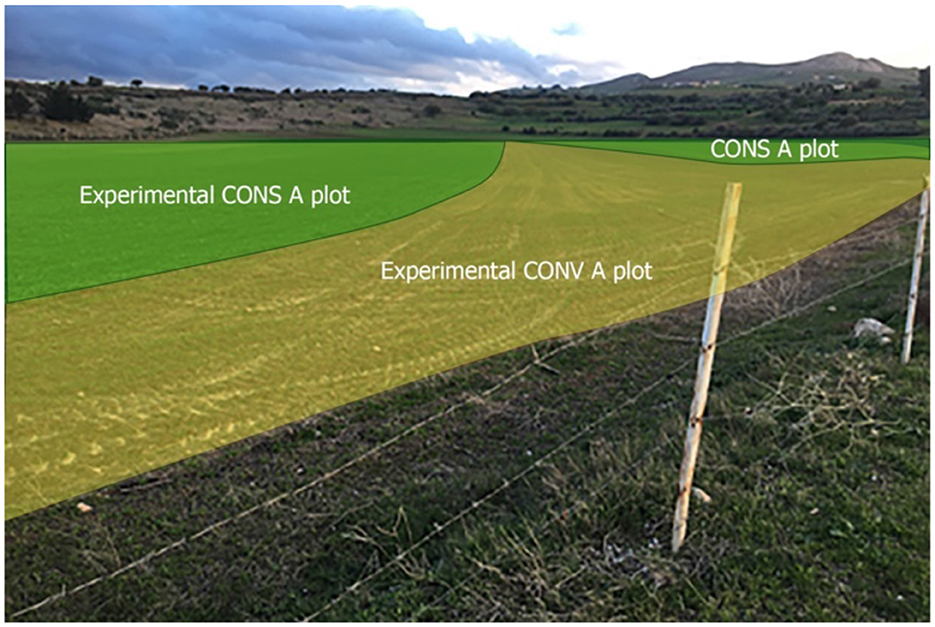
Figure 2. Landscape of CONS A and CONV A plots grazed by experimental lambs in the present study in January.
2.2. Animals
Two batches, each containing six male lambs, were randomly selected from a herd of sheep consisting of 130 Noire de Thibar, Queue Fine de l'Ouest, and cross-breeds. Lambs between 5 and 10 months with a mean liveweight of 24 kg (range: 16–32 kg) were sampled for this study. Animals were vaccinated against enterotoxaemia (Ovipan F®, MCI Santé Animale, Morocco) (two subcutaneous injections of 2 ml/animal at 1-month interval). They were also treated with 7 mg/kg albendazole (Dalben® 1.9, CEVA, France) in late January 2021. Each batch of lambs was randomly divided into two groups, each comprising three male lambs, and maintained in two separate boxes (Figure 3). After a month-long adaptation period, the two groups were randomly placed on pastures for 2 months, one on a conservation agriculture (CONS A) plot and the other on a conventional agriculture (CONV A) plot. Both batches of lamb grazed daily in fenced 25 m2 plots for 6 to 7 h for 3 days, except during rainy days, when they were kept in their boxes. As a food supplement, each lamb received ad libitum oat vetch hay and ~200 g of concentrate.
2.3. Sampling
Every 2 weeks, lambs were clinically examined, weighed, and sampled (5 ml of blood in EDTA tubes and at least 10 g of feces).
Red blood cell count (RBC) (109/mL), haematocrit (Ht) (%), and hemoglobin (Hb) (g/dL) were estimated using an auto-hematology analyzer BC-2800Vet® (Shenzen Mindray Bio-Medical Electronics Co., Ltd., China).
All fecal samples were examined qualitatively (using the flotation technique) and quantitatively (using the McMaster technique) for the presence of gastrointestinal parasites. The latter allowed the estimation of infection intensity that was expressed as eggs per gram (epg) of gastrointestinal nematodes, coccidian oocysts, and whipworms (Trichuris ovis) (18).
After 2 months of grazing, the lambs were slaughtered. Gastrointestinal tracts, lungs, livers, and epiploons were collected, and each carcass was weighed. The collected organs were thoroughly examined and dissected for the presence of lesions. Each portion of the gastrointestinal tract was separated and longitudinally opened. The digestive mucosa was thoroughly washed, and all the content was collected in a bucket. All cestodes and nematodes were collected and washed in 70% ethanol. All the collected parasites were conserved in identified tubes containing 70% ethanol and then stored at +4°C until studied. According to taxonomic criteria, nematodes and segments of adult cestodes were counted and identified (19).
2.4. Parasitological indicators
The following parasitological indicators were estimated (20):
Total Worm Count (TWC) = total number of nematode species found in one examined gastrointestinal tract. A natural logarithmic transformation [Ln (n + 1)] was used in the figures.
Infestation prevalence (%) = 100 × number of infested lambs/number of examined lambs.
Infestation intensity = the number of parasites in the gastrointestinal tract/number of infested lambs.
Infestation abundance = the number of parasites in the gastrointestinal tract/number of examined lambs.
2.5. Statistical analyses
During visits, the mean relative variation was used to compare the variation of lambs' weight, haematocrit, hemoglobin, and blood cell count. The relative variation was estimated as follows:
Mean relative variation (%) = 100 × [value at visit (n + 1) - value at visit (n)]/[value at visit (n)].
Since the number of lambs was low, the comparison of the prevalence of tapeworm infestation during visits between the two lamb batches was performed with Fisher's exact test. The infestation intensity and abundance (EPG, OPG, and whipworms) of the two batches of lambs during the five visits were determined using the Wilcoxon-Mann-Whitney test.
The Kruskal–Wallis test was used to compare the infestation intensity of lambs within the same group from the first to the fifth visit to compare the intra-group infestation intensity.
All tests were considered significant at a 5% threshold (21, 22).
3. Results
3.1. Relative variation of lambs' liveweights
The mean relative variation of lambs' liveweight had exactly the same trend in both animal groups. It decreased considerably on the second visit. There was no statistically significant difference between the liveweights in the two animal groups (Table 1; Figure 4). It is worth mentioning that there is a significant statistical difference in liveweight relative variation in each batch during all visits (Table 1) (P = 0.01 for both lambs' batches).
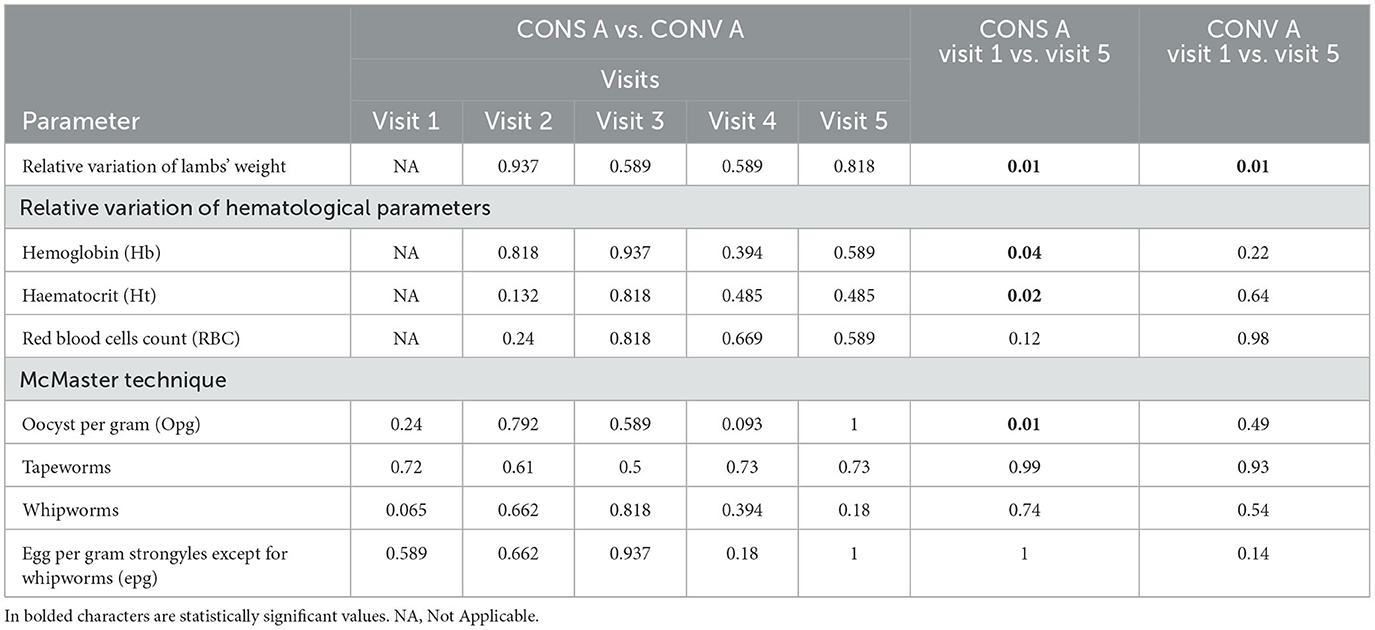
Table 1. P-values of lambs' mean weight relative variation, hematological parameters relative variation, and McMaster technique between the two batches of lambs.
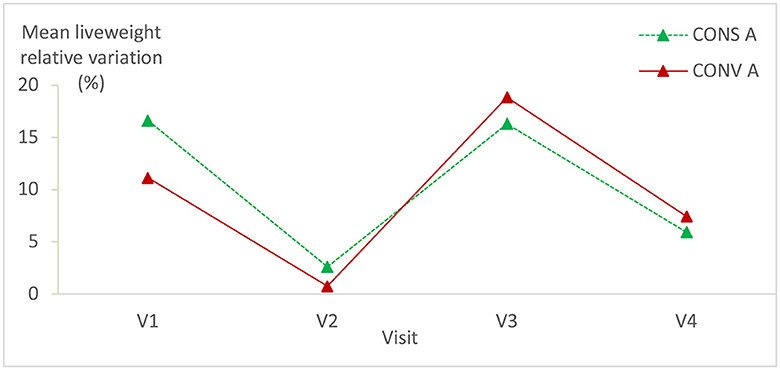
Figure 4. Mean relative variation (in %) of lambs' liveweights in CONS A and CONV A. CONS A, Conservation Agriculture; CONV A, Conventional Agriculture.
The carcass yield was low for lambs in both types of agriculture (44.5 and 45.3% for CONS A and CONV A, respectively) and almost did not exceed the lower limit of the range of carcass yield in sheep (between 45 and 60%) (23). Moreover, there was no statistically significant variation in carcass yield between the two lamb batches (P = 0.39).
3.2. Relative variation of hematological parameters
Hematological parameters were within the normal values of lamb blood parameters in all animals of both groups (24, 25). The hematological parameters had the same variation trend in the two lamb groups (Figures 5–7; Table 1) (p > 0.05).
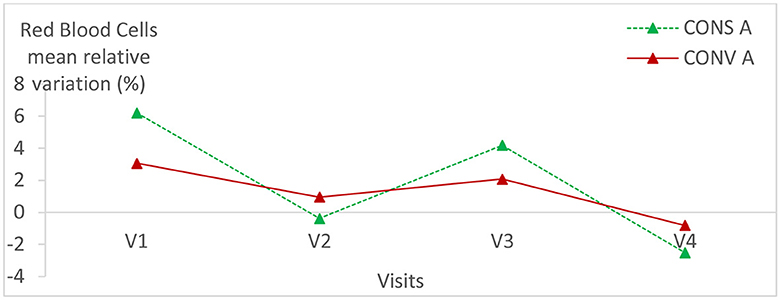
Figure 5. Mean relative variation of red blood cells in the two lamb groups according to visits. CONS A, Conservation Agriculture; CONV A, Conventional Agriculture.
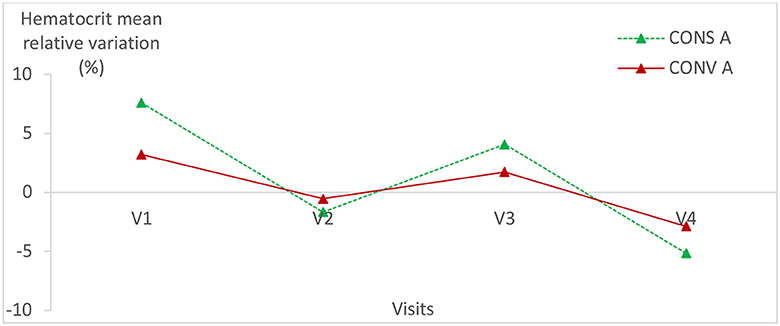
Figure 6. Mean relative variation of haematocrit in the two lamb groups according to visits. CONS A, Conservation Agriculture; CONV A, Conventional Agriculture.
There was no statistically significant difference within each group of lambs except for the hemoglobin relative variation in lambs kept in CONS A (P = 0.04) (Table 1). It increased from the first to the fourth visit and then decreased during the last visit.
3.3. Coproscopic results
The total coccidia oocyst count showed no significant change in the CONV A lamb group of the first batch (Figure 8). In the CONS A group, this value decreased on the second and fourth visits (Figure 8). The total oocyst counts within this group showed a significant statistical variation (P = 0.01) (Table 1).
The prevalence rate of tapeworms (Moniezia spp.) did not change during all visits, and no statistically significant variation was observed (p > 0.99) (Table 2). In another side, the total oocysts count of the CONV A lambs' group, showed the same trend and no statistical significant variation has been recorded (Figure 9).
The eggs' whipworms relative variation in the CONV A lamb group of the first batch peaked during the third visit and reached zero at the last visit (Figure 10). This value was zero from the second visit in the CONS A lamb group (Figure 10). In the second batch, the eggs' whipworms' relative variation was zero throughout the visits in the CONV A lamb group (Figure 11). There were no statistically significant differences between lambs in the two groups during all visits or in the same batch (Table 2).
The relative variation of epg of the other gastrointestinal nematodes was not statistically significant between the two lamb groups or within the same group during all visits (Tables 1, 2 and Figures 12, 13).
The probability of observed infestation prevalence in CONV A and CONS A was 50 ± 0.09% (extreme values: 35.5 and 71.1%) and 56.67 ± 0.09% (extreme values: 39.6 and 73.8%), respectively.
3.4. Helminthologic necropsy
A total of 905 helminth specimens were collected from the 12 slaughtered lambs. Among these helminths, abomasum nematodes were predominant, mainly Ostertagia sp., which were collected from all the lambs of both groups (Figure 13). It represented 94.25% of the total number of parasites (853 worms). The total worm count (TWC) varied between 9 and 190 worms per lamb.
There was no statistical difference between the lamb groups for infestation intensity and abundance (Table 3).
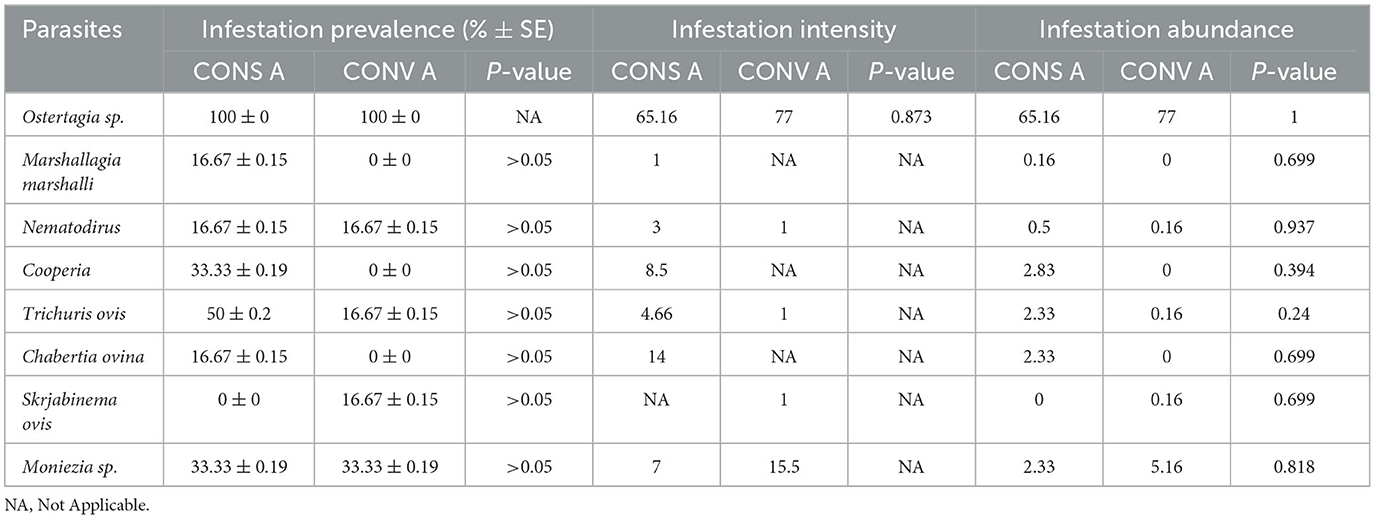
Table 3. Infestation prevalence, intensity, and the abundance of different gastrointestinal parasites in the two lamb groups.
4. Discussion
The environmental benefits of CONS A, especially regarding climate change and land preservation, are very high, and governments should encourage this type of agriculture to maintain the sustainability of agricultural activity and reduce its negative impact on the environment (6, 26, 27). As part of combining crops with livestock, particularly in semiarid areas, CONS A and sheep farming can be harmoniously associated (10, 28).
Parasitic infections constitute a burden in extensive small ruminant breeding because of the subsequent considerable economic losses (11). Thus, parasitic infections are widespread, infestation rates are mostly high (15, 16), and sheep productivity is widely constrained (29).
This low productivity is due to negative repercussions on the general metabolism of infested animals. These effects include decreased appetite, slowed and disrupted nutrient digestion, reduced growth rate, and, in advanced stages, disturbed hematological parameters (30).
On the other side, unless CONS A is a sustainable farming system that has ecological benefits and fits perfectly with the breeding of small ruminants, it risks changing the resistance of certain parasites in the external environment compared to that in CONV A and may alter the epidemiology of parasitic diseases.
Everything mentioned above prompted us to undertake this study. Thus, our study aims to follow up and compare the hematological parameters, the relative variation in live weight, and the gastrointestinal parasite infestation parameters in two batches of lambs grazing in CONS A and CONV A, respectively, during two grazing cycles to determine whether this hypothesis is valid.
To the best of our knowledge, to date, this is the first study to investigate the effect of CONS A on sheep digestive parasitism. We found that the mean relative variation of lambs' liveweight decreased in the second visit in the two animal groups. This could be attributed to the modification of the food regime during the adaptation period. The absence of a statistical difference between lambs' liveweights in the two batches indicates that CONS A did not negatively impact the parasitism or the growth rate of sheep. A statistically significant variation in liveweights was observed in both animal groups during the five visits. This is attributed to the increase in liveweight following the maintenance of lambs' growth, even between the ages of 6 and 12 months (31).
Moreover, the mean carcass yield of the CONS A lamb group (445 g/kg) was slightly lower than the normal yield values for fattening lambs (between 450 and 600 g/kg of body weight) (23). This variation was probably due to genetic traits, gender, age, birth weight, and feeding level (28). There was no statistically significant difference in the mean carcass yield between the two animal batches (CONS A and CONV A lamb batches). These results indicate that growth is not affected when lambs are kept in CONS A pastures. Further studies involving larger lamb samples are needed to consolidate this finding.
No statistically significant difference was found in hematological parameters between the two lamb batches. This proves that the digestive parasite infection level had no impact on the hematological parameters either in CONS A or in CONV A and, consequently, on the metabolism of the studied lambs.
No statistically significant difference was found between the two lamb groups concerning infestation prevalence, intensity, or the abundance of all parasites found. The parasitological study did not show any statistically significant difference regarding infection by Eimeria, whipworms (T. ovis), digestive strongyle eggs, or tapeworms in the two lamb batches. These results confirm that pasturing on CONS A crops has no negative impact on lambs' digestive parasitism.
Eimeria fecal elimination during the grazing period showed the same trend in both types of agriculture, with a higher infection intensity during the wet period. These results are in agreement with those found in grazing sheep in semiarid areas in Brazil (32). There was a statistically significant variation in total oocyst count in lambs grazing on CONS A pasture. The progressive decrease in the total oocyst count in the two batches of CONS A lambs' infection intensity could be explained by a progressive installation of specific anti-Eimeria immunity. This trend was due to the separation of experimental lambs from adult sheep, leading to the absence of lamb contamination from carrier adult sheep (33). The relative increase in total oocyst count at the last visit could be explained by an increase in ambient humidity and temperature during the spring.
The prevalence rate of worms in the two lamb batches showed the same trend. It varied between 16.7 and 66.7% in CONS A and CONV A lamb batches, respectively. In China, a higher prevalence rate in sheep, reaching 96.9%, was reported (34). This relatively low prevalence rate is probably related to good management of pastures and the absence of co-grazing animals in the studied flock with other animals. Worms collected from the digestive tract of lambs were mainly represented by abomasum parasites. This is in agreement with the two studies conducted on sheep gastrointestinal parasites in North Tunisia (15, 16). We found herein that Ostertagia sp. was the predominant nematode genus (94.25%), unlike the two studies cited above, which reported a predominance of Teladorsagia sp. with an infection prevalence reaching 91.25 and 90.03%, respectively. This is probably related to the rainfall and ambient temperature, which constitute the two main factors conditioning the survival of the outdoor parasite stages in the soil (eggs and larvae).
5. Conclusion
We conclude that grazing on CONS A plots has no impact on sheep digestive parasitism compared to those grazing in CONV A. Similarly, we showed that there is almost no difference in lamb growth rate, carcass yield, or hematological parameters between lambs kept in the two pasture types. Further studies are needed to support these findings, especially on a larger animal sample, and to explore the impact of CONS A on other parasites (liver flukes and tick-borne infections) and other domestic animal herbivores. Unless these studies prove the opposite, sheep owners do not have to implement specific antiparasitic control measures on sheep grazing on CONS A.
Data availability statement
The original contributions presented in the study are included in the article/supplementary material, further inquiries can be directed to the corresponding author.
Ethics statement
The animal studies were approved by the approval code: CEEA-ENMV 65/22 approval date: December 29, 2022 Animal Ethics Committee – National School of Veterinary Medicine, AEC/IACUC, ENMV- Sidi Thabet, Tunisia. The studies were conducted in accordance with the local legislation and institutional requirements. Written informed consent was obtained from the owners for the participation of their animals in this study.
Author contributions
Conceptualization: SE, MG, MR, and HC. Methodology and writing—review and editing: MG and SE. Validation: MG, MR, and HC. Formal analysis and investigation: SE, LS, and MD. Resources, writing—original draft preparation, and data curation: SE. Supervision and project administration: MG. Funding acquisition: MR. All authors have read and agreed to the published version of the manuscript.
Funding
This research was funded by the ICARDA in the frame of the CLCA project (BUS200341).
Acknowledgments
This research was conducted as part of the IFAD Funded Use of Conservation Agriculture in Crop-Livestock Systems (CLCA) in the Drylands for Enhanced Water Use Efficiency, Soil Fertility and Productivity in NEN and LAC Countries Project under a grant agreement with the International Center for Agricultural Research in the Dry Areas (Agreement No. 20016). This work was also partially funded by the CGIAR Initiative on Agroecology (Agreement No. 200302). We would like to thank all funders who support the CGIAR Initiative on Agroecology through their contributions to the CGIAR Trust Fund. Special thanks are addressed to Mr. Adnen ABED RABBAH, the owner of the sheep herd and the plots of conservation and conventional agriculture. We commend his continued efforts to preserve and promote this mode of eco-agriculture since the 2000s.
Conflict of interest
The authors declare that the research was conducted in the absence of any commercial or financial relationships that could be construed as a potential conflict of interest.
Publisher's note
All claims expressed in this article are solely those of the authors and do not necessarily represent those of their affiliated organizations, or those of the publisher, the editors and the reviewers. Any product that may be evaluated in this article, or claim that may be made by its manufacturer, is not guaranteed or endorsed by the publisher.
References
1. Gordon E, Davila F, Riedy C. Transforming landscapes and mindscapes through regenerative agriculture. Agric Hum Values. (2022) 39:809–26. doi: 10.1007/s10460-021-10276-0
2. Guidoboni MV, Duparque A, Boissy J, Mouny JC, Auberger J, van der Werf HM. Conservation agriculture reduces climate change impact of a popcorn and wheat crop rotation. PLoS ONE. (2023) 18:e0285586. doi: 10.1371/journal.pone.0285586
3. Kassam A, Friedrich T, Shaxson F, Pretty J. The spread of conservation agriculture: Justification, sustainability and uptake. Int J Agric Sust. (2009) 7:292–320. doi: 10.3763/ijas.2009.0477
4. Djamen P, Andrieu N, Bayala I, Coulibaly K, Dabiré D, Diallo A, et al. Acquis et défis de l'agriculture de conservation. Grain de Sel. 63–6, 26–7.
5. Colley TA, Olsen SI, Birkved M, Hauschild MZ. Delta life cycle assessment of regenerative agriculture in a sheep farming system. Integr Environ Assess Manag. (2020) 16:282–90. doi: 10.1002/ieam.4238
6. Kassam A, Friedrich T, Shaxson F, Bartz H, Mello I, Kienzle J, et al. The spread of Conservation Agriculture: policy and institutional support for adoption and uptake. Field Actions Sci Rep. (2014) 7:12. Available online at: http://journals.openedition.org/factsreports/3720
7. FAO. Regards sur l'agriculture de conservation en Afrique de l'ouest et du centre et ses perspectives “Views on conservation agriculture in West and Central Africa and its prospects.” In: Congrès mondial d'agriculture de conservation. FAO (2005). p. 114.
8. Lemaire G, Garnier J, da Silveira Pontes L, de Faccio Carvalho PC, Billen G, Simioni Assmann T. Domestic herbivores, the crucial trophic level for sustainable agriculture: avenues for reconnecting livestock to cropping systems. Agronomy. (2023) 13:982. doi: 10.3390/agronomy13040982
9. Dhehibi B, Fouzai A, Frija A, Adhim MA. M'hamed HC, Ouerghemmi H, Rekik M. Assessing complementary synergies for integrated crop–livestock systems under conservation agriculture in Tunisian dryland farming systems. Front Sust Food Syst. (2023) 6:1–18. doi: 10.3389/fsufs.2022.1022213
10. Dhehibi B, Souissi A, Fouzai A, Frija A, Abdeladhim MA, Rekik M. Efficiency of crop–livestock production systems under conservation agriculture: scope for sustainable system transformation to achieving food security in rain-fed drylands of Tunisia. In: Conference Paper (2022).
11. Charlier J, Rinaldi L, Musella V, Ploeger HW, Chartier C, Vineer HR. Initial assessment of the economic burden of major parasitic helminth infections to the ruminant livestock industry in Europe. Prev Vet Med. (2020) 182:1–42. doi: 10.1016/j.prevetmed.2020.105103
12. Tariq KA, Chishti MZ, Ahmad F, Shawl AS. Epidemiology of gastrointestinal nematodes of sheep managed under traditional husbandry system in Kashmir valley. Vet Parasitol. (2008) 158:138–43. doi: 10.1016/j.vetpar.2008.06.013
13. Krishnamoorthy P, Lakshmi HK, Jacob SS, Suresh KP, Shome BR. Scientometric analysis of gastrointestinal parasites prevalence in sheep and goats of India. Acta Parasitologica. (2023) 13:1–24. doi: 10.1007/s11686-023-00687-w
14. Waruru RM, Mutune MN, Otieno RO. Gastrointestinal parasite infections of sheep and goats in a semi-arid area of Machakos District, Kenya. Bullet Anim Health Prod Africa. (2005) 53:25–34. doi: 10.4314/bahpa.v53i1.32686
15. Akkari H, Gharbi M, Darghouth MA. Dynamics of infestation of tracers lambs by gastrointestinal helminths under a traditional management system in the North of Tunisia. Parasite. (2012) 19:407–15. doi: 10.1051/parasite/2012194407
16. Rouatbi M, Romdhane R, Bouaicha F, Saddem R, Sassi L, Dhibi M, et al. Individual variability among autochthonous sheep in Northern Tunisia to infection by abomasum nematodes and Babesia/Theileria parasites. Vet Med Sci. (2020) 6:834–45. doi: 10.1002/vms3.310
17. Smaoui A. Bioclimat et Végétation de la Tunisie et des régions prospectées pendant le 12ème ITER Mediterraneum de OPTIMA. Bocconea. (2015) 27:13–20. doi: 10.7320/Bocc27.1.013
18. Raynaud JP, William G, Brunault G. Etude de l'efficacité d'une technique de coproscopie quantitative pour le diagnostic de routine et le contrôle des infestations parasitaires des bovins, ovins, équins et porcins. Annal Parasitol Hum Comp. (1970) 45:321–42. doi: 10.1051/parasite/1970453321
20. Bush AO, Lafferty KD, Lotz JM, Shostak AW. Parasitology meets ecology on its own terms: Margolis et al. revisited. J Parasitol. (1997) 1:575–83. doi: 10.2307/3284227
23. Fimbres H, Hernández-Vidal G, Picón-Rubio JF, Kawas JR, Lu CD. Productive performance and carcass characteristics of lambs fed finishing ration containing various forage levels. Small Rum Res. (2002) 43:283–8. doi: 10.1016/S0921-4488(02)00014-7
24. Adili N, Melizi M, Belabbas H. Species determination using the red blood cells morphometry in domestic animals. Vet World. (2016) 9:960–3. doi: 10.14202/vetworld.2016.960-963
25. Ahmadi-Hamedani M, Ghazvinian K, Atyabi N, Khanalizadeh P, Masoum MA, Ghodrati MS. Hematological reference values of healthy adult Sangsari sheep (Iranian fat-tailed sheep) estimated by Reference Value Advisor. Comp Clin Path. (2016) 25:459–64. doi: 10.1007/s00580-015-2211-z
26. Parihar CM, Parihar MD, Sapkota TB, Nanwal RK, Singh AK, Jat SL. Long-term impact of conservation agriculture and diversified maize rotations on carbon pools and stocks, mineral nitrogen fractions and nitrous oxide fluxes in inceptisol of India. Sci Total Environ. (2018) 640:1382–92. doi: 10.1016/j.scitotenv.2018.05.405
27. Nandan R, Pal Poonia S, Shankar Singh S, Prasad Nath C, Kumar V, Kanwar Malik R, et al. Potential of conservation agriculture modules for energy conservation and sustainability of rice-based production systems of Indo-Gangetic Plain region. Environ Sci Pollut Res. (2021) 28:246–61. doi: 10.1007/s11356-020-10395-x
28. Abidi S, Benyoussef S, Ben Salem H. Foraging behaviour, digestion and growth performance of sheep grazing on dried vetch pasture cropped under conservation agriculture. J Anim Physiol Anim Nutr. (2021) 105:51–8. doi: 10.1111/jpn.13456
29. Tariq KA, A. Review of the epidemiology and control of gastrointestinal nematode infections of small ruminants. Proc Nat Acad Sci India Sec Biol Sci. (2015) 85:693–703. doi: 10.1007/s40011-014-0385-9
30. Hoste H, Torres-Acosta JF, Quijada J, Chan-Perez I, Dakheel MM, Kommuru DS, et al. Interactions between nutrition and infections with Haemonchus contortus and related gastrointestinal nematodes in small ruminants. Adv Parasitol. (2016) 93:239–351. doi: 10.1016/bs.apar.2016.02.025
31. Saeid Bathaei S, Leroy PL. Genetic and phenotypic aspects of the growth curve characteristics in Mehraban Iranian fat-tailed sheep. Small Rum Res. (1998) 29:261–9. doi: 10.1016/S0921-4488(97)00142-9
32. Souza LE, Cruz JF, Teixeira Neto MR, Albuquerque GR, Melo AD, Tapia DM. Epidemiology of Eimeria infections in sheep raised extensively in a semiarid region of Brazil. Rev Bras Parasitol Vet. (2015) 24:410–5. doi: 10.1590/S1984-29612015070
33. Carrau T, Silva LM, Pérez D, Failing K, Martínez-Carrasco C, Macías J, et al. Associated risk factors influencing ovine Eimeria infections in southern Spain. Vet Parasitol. (2018) 263:54–8. doi: 10.1016/j.vetpar.2018.10.004
Keywords: conservation agriculture, conventional agriculture, digestive parasites, sheep, Tunisia
Citation: ElHamdi S, Sassi L, Rekik M, Dhehibi M, Cheikh M'hamed H and Gharbi M (2023) Conservation agriculture has no significant impact on sheep digestive parasitism. Front. Vet. Sci. 10:1244355. doi: 10.3389/fvets.2023.1244355
Received: 22 June 2023; Accepted: 21 August 2023;
Published: 21 September 2023.
Edited by:
Vikrant Sudan, Guru Angad Dev Veterinary and Animal Sciences University, IndiaReviewed by:
Joshua Orungo Onono, University of Nairobi, KenyaNdubuisi Machebe, University of Nigeria, Nsukka, Nigeria
Copyright © 2023 ElHamdi, Sassi, Rekik, Dhehibi, Cheikh M'hamed and Gharbi. This is an open-access article distributed under the terms of the Creative Commons Attribution License (CC BY). The use, distribution or reproduction in other forums is permitted, provided the original author(s) and the copyright owner(s) are credited and that the original publication in this journal is cited, in accordance with accepted academic practice. No use, distribution or reproduction is permitted which does not comply with these terms.
*Correspondence: Sihem ElHamdi, c2loZW12ZXQyMDA1QGdtYWlsLmNvbQ==
 Sihem ElHamdi
Sihem ElHamdi Limam Sassi2
Limam Sassi2 Mourad Rekik
Mourad Rekik Hatem Cheikh M'hamed
Hatem Cheikh M'hamed Mohamed Gharbi
Mohamed Gharbi